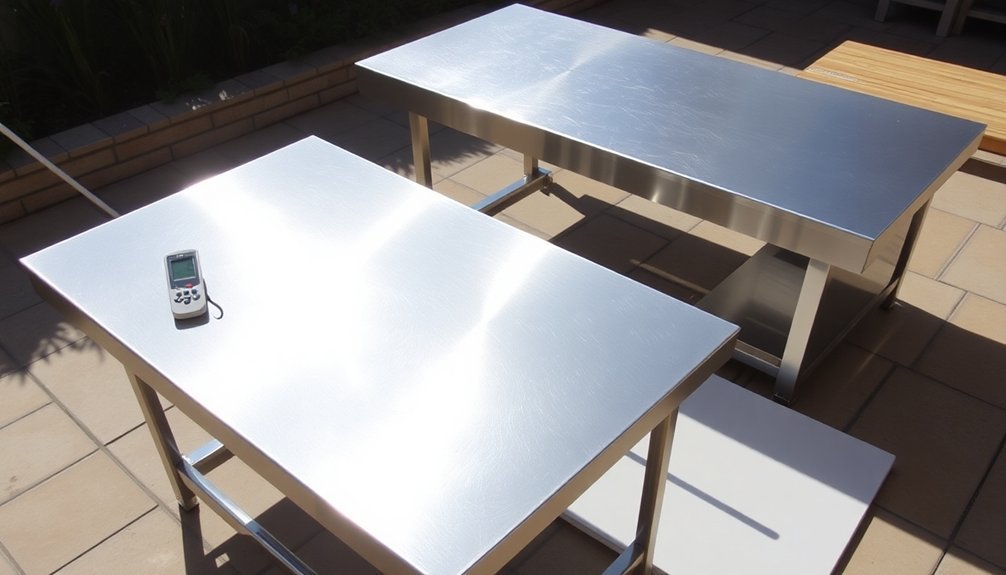Start with perfectly ripe tropical fruits by selecting specimens that are firm yet slightly giving when pressed, showing rich colors and sweet aromas without bruises or soft spots. Before drying, you'll want to pre-treat your sliced fruits by soaking them in a natural solution for 2-15 minutes, then rinsing and draining thoroughly. For outdoor drying success, place uniform fruit slices on elevated trays covered with cheesecloth, ensuring good air circulation while protecting from insects and birds. Turn pieces regularly and bring trays inside at night. These foundational steps will set you up for consistently successful fruit preservation at home.
Selecting Perfect Tropical Fruits

Most tropical fruits require careful selection to guarantee they're ideal for drying. When choosing papayas, look for ones that are 75% to 100% yellow, firm, and heavy for their size. Avoid any with bruises or soft spots, though you can select slightly green ones if you'll dry them later.
For mangoes, you'll want fruits that give slightly under pressure and emit a fragrant smell. While color isn't a reliable indicator, they may display red or yellow skin when ripe. Local sourcing ensures the freshest fruits for optimal drying results. Don't select mangoes with bruises or dark blemishes.
When selecting pineapples, choose ones that are heavy and have dark green leaves. The fruit should be firm with a sweet aroma, and you'll want to avoid any with soft spots or yellowing leaves.
For other tropical fruits, select jicama with firm texture and smooth, shiny skin, avoiding those with blemishes.
When choosing avocados, pick them when they're deep green or showing a reddish blush, and they should be firm but slightly giving.
For pawpaws, look for fruits with a fruity fragrance that have changed from green to yellow or blush, giving slightly when pressed.
Natural Pre-Treatment Solutions
To apply these pre-treatments, first wash and slice your fruits.
Then, soak them in your chosen solution for 2-15 minutes, depending on the fruit type.
Use a slotted spoon to remove the fruit pieces and rinse them lightly under cold water.
Make certain to prepare fresh solution for each batch, as the effectiveness decreases with air exposure.
After treatment, drain the fruit pieces well before arranging them on your drying trays.
For the best results, guarantee proper air circulation during the drying process.
Consider using ascorbic acid solutions to maintain color and prevent darkening of light-colored fruits.
Outdoor Drying Success

Successful outdoor drying of tropical fruits starts with proper preparation and setup of your drying area.
You'll need to wash your fruits thoroughly and slice them uniformly – opt for thin pieces that'll dry faster. If you're leaving the peel on, remember it'll extend your drying time, and some fruits need their skins "checked" to speed up the process.
Set up your drying trays on blocks to maximize air circulation, and place them on concrete or aluminum surfaces to increase temperature. Don't forget to cover the trays with cheesecloth to keep birds and insects away. This method mirrors the ancient Middle Eastern tradition of naturally preserving fruits.
You'll need to bring your trays inside at night to prevent moisture from affecting the fruit. Keep your fruit pieces in a single layer and turn them occasionally with a metal spatula for even drying.
If you're in a humid area, you might want to use fans to maintain steady airflow. Monitor your fruits closely, especially near the end of the drying period.
Once dried, let your fruits cool completely before conditioning them in jars for 7-10 days. Check daily for condensation – if you spot any, continue drying.
Store your finished product in sealed containers away from light and moisture.
Frequently Asked Questions
How Long Can Dried Tropical Fruits Be Stored Before They Go Bad?
You can store dried tropical fruits for 6-12 months at room temperature, 12-18 months in your refrigerator, or up to 18+ months in your freezer. They'll last longest in airtight containers with low humidity.
Can Different Tropical Fruits Be Dried Together on the Same Tray?
Yes, you can dry different tropical fruits together on the same tray, but you'll need to monitor them closely since they dry at different rates. You might need to remove some pieces before others finish drying.
What Signs Indicate That Tropical Fruits Are Too Dry or Overdried?
You'll know your tropical fruits are overdried when they're brittle and snap easily, show visible cracks, lack any moisture when cut, appear overly dark, and won't regain their texture even after rehydration.
Should Tropical Fruits Be Completely Dry Before Packaging, or Slightly Moist?
You shouldn't dry tropical fruits completely before packaging. They need about 20% moisture content, making them leathery and springy. If they're too dry, they'll become brittle and lose flavor quality.
Can Dried Tropical Fruits Be Rehydrated for Use in Cooking?
Yes, you can easily rehydrate dried tropical fruits for cooking. You'll need to soak them in your choice of liquid – water, fruit juice, or even alcohol – until they're tender and ready to use.
In Summary
You'll find natural fruit drying becomes second nature once you've mastered these basic steps. Remember to select fully ripe fruits, pre-treat them properly with natural solutions, and guarantee ideal outdoor drying conditions. Don't let imperfect results discourage you – with practice, you'll develop an intuitive feel for timing and techniques. Start small, experiment with different tropical fruits, and enjoy your homemade dried treats year-round.





Leave a Reply